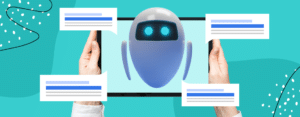It takes time to discover the right marketing strategy for your brand and often involves both hits and misses along the way.
One mistake, in particular, that many brands make today is focusing only on what they offer in terms of products or services. This leads to static content that has the potential to reach only a tiny fraction of intended audiences.
So, what is the solution? Think about your target audience.
So much depends on the characteristics, actions, behaviors, demographics, pain points, and expectations of those potential customers, so getting to know them better is a good place to start.
To help with this, consider the benefits of customer segmentation and the creation of distinct buyer personas for each segment.
Customer segmentation provides your business with a refined way to target your customers and create a better overall experience. In turn, it can strategically guide your marketing strategy to greater success.
Ready to learn more? Keep reading our post!
- What is Customer Segmentation?
- 9 Benefits of Customer Segmentation
- 7 Customer Segmentation Models
- How to Do Customer Segmentation
- 6 Customer Segmentation Tools
- Customer Segmentation Examples
- Wrap Up
What is Customer Segmentation?
Customer segmentation is the precise process of dividing your customers into particular groups based on common traits, characteristics, or other factors.
With this, you can better optimize your marketing efforts.
This approach provides you with a way to manage your customer relationships. It also serves as a guide for a more personalized marketing approach, and this can boost conversions, revenue, and customer loyalty.
How is Customer Segmentation Different from Market Segmentation?
Confusion often surrounds customer segmentation and how it differs from market segmentation.
However, all you essentially need to do is look at the wording of each.
Market segmentation is more general, encompassing the entire marketplace before breaking it down into segments. Customers are grouped together based on the services or products they purchase, such as certain types of software or housing.
Customer segmentation, on the other hand, focuses only on your part of the market, then drilling down and pulling out data details on the customers themselves.
This way, you gain a clear sense of who your audiences are and who you need to target your marketing efforts.
9 Benefits of Customer Segmentation
Customer segmentation can be beneficial in a number of ways, allowing marketing teams to tailor efforts to their specific customers.
When done in the best possible way, those benefits include:
1. Ability to Create and Share More Targeted Messaging
With customer segmentation, marketers can better craft messaging that resonates with their particular customers, focusing on their specific interests and needs.
Also, it allows you to determine the best ways to share that message with your target audience, which may be social media posts or email.
2. Improve the Customer Experience
Creating a good customer experience with your website, emails, messaging, and overall content is essential to boosting conversions and increasing your revenue.
With customer segmentation, you can better optimize these experiences to match their needs and preferences.
Personalization and customization of your content to match a particular customer segmentation lead to a feeling of appreciation and understanding, making your customers’ experience with your brand stand out.
3. Help You Discover Optimal Pricing
The better you know and understand your ideal customers, the more information you’ll have on the prices they will be willing to pay for one of your services or products.
Use what you learn to try out pricing options and test the waters to discover the best range for your particular customers.
As a result, you can use this information to competitively price your service or product to ensure the potential for boosting purchase levels.
4. Build and Maintain Better Customer Relationships and Enhance Retention
With a better understanding of your customers, thanks to the segmentation process, you can customize your approach and content to match their particular preferences, wants, needs, and pain points.
Customers delight in being understood and appreciated in this manner and are more likely to build a relationship with your company or brand.
In turn, you build and maintain better relations and interactions and enhance retention and customer loyalty.
Along with this customer loyalty is an increase in customer lifetime value, meaning they spend more the longer they stay with your brand.
5. Allow you to Focus Your Attention on the Most Profitable Customers
With the customer segmentation approach, you have the ability to narrow down who your most profitable customers are and focus your marketing efforts there.
You’ll be able to identify those customers most interested in what you have to offer or will make repeat purchases as well.
6. Can Lead to Upsell and Cross-Sell Opportunities
Customer segmentation can increase upsell and cross-sell opportunities.
Customers who already bought a product or service from your company are more likely to buy other things you offer.
Using the segmentation approach, you can look at what your customers have already purchased and offer other similar products or services they may be interested in as well (e.g., Amazon’s “you may also like” suggestions).
7. Increase ROI
With better targeting of your resources, segmentation can increase your overall marketing ROI by getting your messaging to your targeted audience.
Marketing campaigns become more effective, leading to higher conversions and a boost in revenue.
8. Provides a Way to Collect Feedback
As the marketplace continues to become overcrowded, you need to break through and stand out with your customers.
By segmenting your customers to those who already show interest in what you have to offer, and marketing to them directly, you can gather feedback to discern if continued tailoring or improvement is required for your digital marketing strategy.
You may also discover whether or not your products or services are meeting the needs of customers or adjustments need to be made.
9. Leads to Better Allocation of Resources
Marketing budgets and resources are rarely open-ended.
An approach such as segmentation allows you to narrow down the targeted audience, and this leads to a better allocation of those available resources to meet ultimate goals.
7 Customer Segmentation Models
Customer segmentation can be approached by way of several different models, including the following most common ones used by marketers today.
1. Demographic Segmentation
Customer demographics include such factors as age, gender, marital status, education, occupation, and income.
2. Geographic Segmentation
Geographic segmentation includes customer locations, including town, city, state, and country. This segmentation model is particularly useful to local businesses or those targeting a specific area.
3. Behavioral Segmentation
Behavioral segmentation model centers on customers’ behaviors, tendencies, habits, purchase history, browsing history, and such things as average order value.
4. Psychographic Segmentation
The focus of psychographic segmentation centers around the consumer’s personality traits, interests, opinions, and attitudes.
5. Technographic Segmentation
Technographic segmentation is based on such factors as preferred technologies, software, and device usage, such as mobile or desktop.
6. Needs-based segmentation
Needs-based segmentation focuses on the needs of specific groups and preferred products or services to fulfill those needs.
7. Values-based segmentation
Values-based segmentation looks more at the economic value of a customer group.
How to Do Customer Segmentation
Here are the steps to take to efficiently go about doing customer segmentation for your organization and marketing efforts.
1. Determine goals and preferred outcomes
As with any strategy, you first need to determine the goals you wish to accomplish with customer segmentation and what the preferred outcomes are for each.
Armed with this big picture information, you can better devise your marketing strategy for meeting these specific goals and outcomes and incorporate ways to measure success rates.
2. Select your segmentation model or models
With your goals in mind, select which segmentation models will be most beneficial.
You may choose to rely on just one, such as demographics, or require two or more, like geographic and behavioral models.
3. Gather Data
For segmentation approaches, you will need to gather and analyze data about your customers.
Examples of ways to gather this information include:
- Pulling from purchasing data, including product or service purchased or geographic location of the buyer.
- Discovering initiating resources or how your customer found your website (what led them to you).
- Finding out opt-in source.
- Examining demographic data input by the customers themselves.
- Utilizing surveys, interviews, or focus groups.
4. Determine Best Ways to Target Customer Segments
With segmentation completed, next up is determining the best ways to target those customers.
This may include customizing content to boost brand awareness or educate your customer segment about your product or service.
Along with targeting, you need to find the best way to reach those customers, whether it be through a particular social media platform, email campaign, or other content channels.
5. Conduct Analysis of Your Efforts
After implementing your segmentation marketing strategy, go back and analyze your efforts and results to gain beneficial insights.
By doing so, you can refine, update, replace, or better optimize your approach.
6 Customer Segmentation Tools
There are numerous online tools available today to help with the customer segmentation process. Here are 6 in particular that can aid your approach.
1. Google Analytics
Google Analytics can monitor your overall website traffic, and this can help you discover the demographics and behaviors surrounding your visitors. In turn, you can determine the best ways to segment them into groups.
2. HubSpot
HubSpot provides a host of tools you can utilize in your segmentation efforts, such as contact scoring, contact lists (both static and active), event-based segmentation, and more.
3. Experian
Build, view, and even manage your customer segments within Experian. At the heart of this tool is a focus on data, that is, collecting, combining, and analyzing it to achieve a greater understating of customers with an eye on meeting their needs.
One example of their offerings is lifestyle segmentation, identifying the habits and preferences of customers.
4. Qualtrics
Qualtrics is a software that provides segmentation tools based on the actions of your customers and the insights gained from these. Within this software, you can organize customer groups and determine the best communication methods.
With its AI and machine learning capabilities, it can also help you find new ways to undergo customer segmentation.
5. Sprout Social
It’s unwise to leave out social media in a marketing strategy these days. Sprout Social can help by making it easier for you to create and share various messages through what they call Audience Targeting on both Facebook and LinkedIn.
6. Mailchimp
Mailchimp continues to be a useful tool for marketing teams in a variety of ways. As a customer segmentation tool, it can assist with better management of customized, segmented email campaigns.
Customer Segmentation Examples
Several customer segmentation examples are available to guide you in your decision-making process and when it comes to incorporating the different segments into your overall digital marketing strategy.
Below are several of these examples to help get you on the right track, including demographic, geographic, psychographic, and technographic ones.
1. Gender (Demographic)
Depending on what services or products you offer, customer segmentation by gender may be beneficial. Take a look at who your customers are and determine if it makes sense to use gender as a grouping factor for marketing efforts.
2. Age (Demographic)
Age is by far one of the most common factors used in segmentation approaches. A customer’s age or age range can provide important information, such as individual budgets, financial priorities at certain stages of life, and more.
3. Occupation (Demographic)
A consumer’s occupation provides you with information not only on career choices but also about their interests and income.
4. Location (Geographic)
The location of your customers is an important factor, alerting you to where they reside and the different approaches to take. Your marketing messages will most likely differ for those who live in New York City versus those in beach communities in Florida.
5. Transportation (Geographic)
A less obvious factor to use in customer segmentation marketing is transportation. You may find that your customers often take buses or subways, and this can benefit from direct marketing (e.g., ad signage on buses or at subway stations). For those customers found walking, such as in big cities, guerilla marketing techniques may be successful.
6. Lifecycle Stage (Behavioral)
Knowing where your customers are in their buyer’s journey is another segmentation possibility. This information provides you with clues as to how to approach them where they are, whether that is in the awareness, consideration, or decision stage.
7. Interests (Psychographic)
By grasping what the interests are of a customer segment, whether they relate directly to your product or service or not, you can find ways to get their attention. For instance, if your customers are outdoor exercise enthusiasts, you may choose to partner with another business or cross-promote your products with an outdoor shoe or hiking store or company.
8. Original Source (Technographic)
Knowing how your customers found you is another good source of information to segment customers. Original source data informs you of how visitors got to your website.
Was it due to your SEO efforts and ranking high up on search results on Google? Did another website refer them to you, or did they read one of your guest posts somewhere?
Once you know, you can concentrate on how to attract more people and optimize the path they need to take to get to you.
Wrap Up
When it comes to your marketing strategy, the customer needs to be front and center.
Instead of focusing on the masses, you’ll benefit from segmenting customers into groups that can be targeted with specific marketing tactics.
Customer segmentation allows you to learn more about your customers, help you tailor and customize content more effectively, create successful targeted campaigns, increase customer loyalty, and help you find the right platforms and channels to reach the most people.
There are many ways to break your customers out into groups. Once you find what works best for your brand, you can then create buyer personas to guide you, then follow each one along their customer’s journey path to know what to do next.
[ion_script src=”https://ionfiles.scribblecdn.net/scripts/ionizer-1.4.2.min.js” hash=”eyJ1cmwiOiIvL2ludGVyYWN0aXZlLnJvY2tjb250ZW50LmNvbS90aGViZWF0LWJhbm5lcj9faW9uX3RhcmdldD1lbWJlZC0xLjAiLCJpZCI6Il9pb25faW9uaXplcl8xNzA2NzE5NDQ4MTI4IiwiZnVsbFNjcmVlbiI6ZmFsc2V9″]









